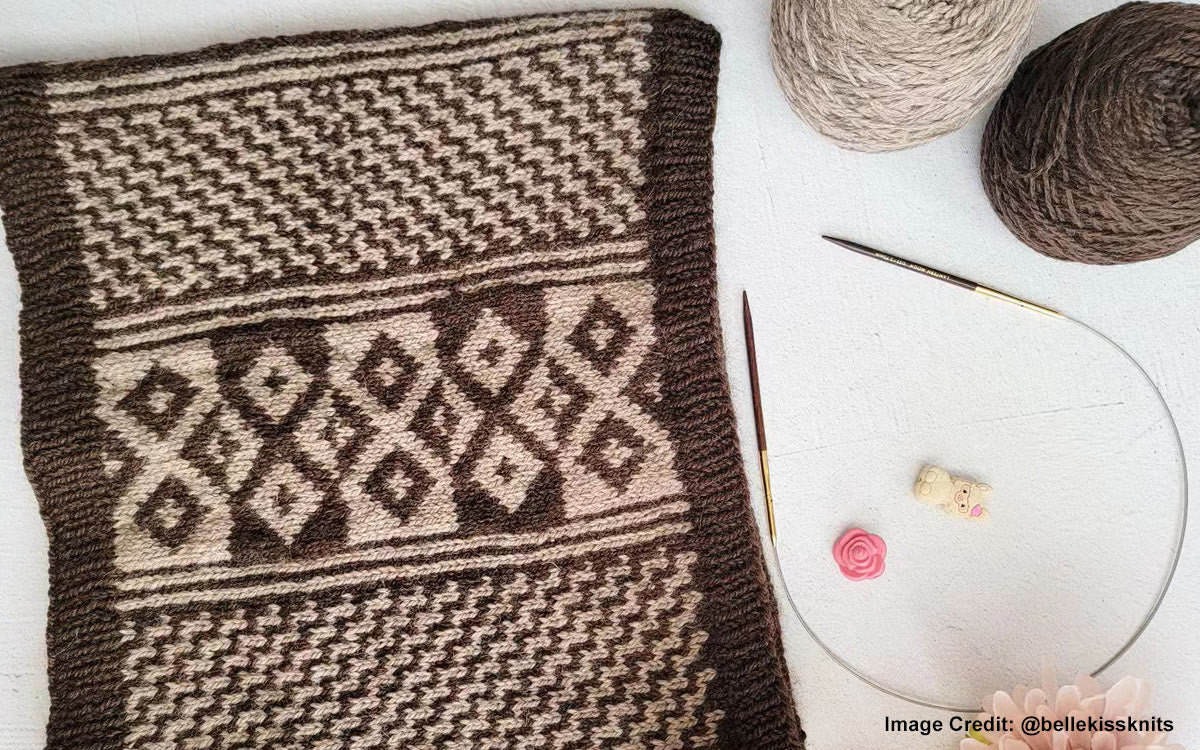
Stranded color work is an easy way to add color to your project when you want to work with different colors of yarns repeating in the same row or rounds, keeping both strands connected to the work. You basically work with your favorite pair or set of knitting needles and work with multiple yarn balls to create shapes or designs. This looks difficult and tricky, but actually, it’s pretty simple. As long as you are confident with your knit and purl stitches, you can take up stranded colorwork knitting. Take a glance at our previous guide on knit and purl stitches for beginners.
Once you understand the basics of this stranded knitting, you can complete a beautiful project with this technique. You can get started with a scarf, hat or other projects. But, it is always recommended to begin small such as a dishcloth or scarf and a simple pattern. Whether you knit back and forth or in the round with any pair of single-pointed needles or any length of circular knitting needles or even a set of double-pointed needles, you can work stranded colorwork. For your initial projects, follow a pattern designer’s set of instructions or you can also plan your own, once you understand the basics of color theory for yarns, etc. In this blog, we will discuss some tips that will help you to craft your project beautifully.
Getting Started with Stranded Colorwork Knitting
Stranded colorwork knitting, also known as Fair Isle knitting or stranded knitting, is a technique that involves working with multiple colors of yarn in the same row or round to create intricate and colorful patterns. It is a traditional knitting method that originated in the Fair Isle region of Scotland.
In stranded colorwork knitting, two or more colors of yarn are used in a single row or round, with each color typically carried along the back of the work as floats while not in use. The floats are strands of yarn that are not actively being knit but are carried behind the stitches until they are needed again.
The key to successful stranded colorwork is maintaining an even tension throughout the project to ensure the stitches are not too loose or too tight. This helps to prevent the floats from becoming too long or distorting the fabric.
Here are the basic steps involved in stranded colorwork knitting:
Step 1- Yarn selection
Choose the colors of yarn you want to use in your project. Typically, a main color (MC) and one or more contrasting colors (CC) are selected.
Step 2 - Holding the yarn
Hold one color in each hand, with the MC in your dominant hand and the CC in your non-dominant hand. Alternatively, you can hold both colors in the same hand, using one color to knit continental style and the other color to knit English style.
Step 3 - Working on the pattern
Follow the pattern instructions, which usually chart out the colorwork design row by row or round by round. Each square or symbol on the chart represents a stitch and indicates which color to use.
Step 4 - Carrying the yarn
When switching between colors, twist the yarns together on the wrong side of the work to avoid creating long floats. This is usually done every few stitches or as instructed by the pattern.
Step 5 - Tension control
Pay attention to your tension while working with multiple colors. Keep the floats loose enough to allow the fabric to stretch but not so loose that they sag or create visible loops on the right side of the work.
Stranded colorwork knitting allows for a wide range of design possibilities, including geometric patterns, motifs, or pictorial representations. It can be used to create beautiful sweaters, hats, mittens, socks, and other knitted items. The technique requires practice and attention to detail but can result in stunning and intricate finished pieces.
How to Make Stranded Knitting Smooth
The main issue with beginners is that they pull the strand very tightly on the knitting needles while changing between the yarn colors. It is suggested that the floating thread at the back of the work should be flexible enough to allow the front side to lie flat. If it has folds during knitting or it appears as a zig zag-shaped piece, it means you are pulling the thread too tightly. On the other hand, the floats shouldn’t be too loose that it feels like holes in your project. It is just a waste of yarn and doesn’t appear beautiful.
1. Use Relatively Bigger Needle As Compared to Stockinette Stitch
As mentioned, some knitters keep the thread tight in the colorwork technique. It is best to use 1-2 size bigger knitting needles as compared to the needles used in stockinette. This will result in uniform tension. If you are working with interchangeable circular knitting needles it gets easier to switch the needle size allowing the project to rest on the cords. If you are working with DPNs or single points you will need to transfer the stitches very carefully.
2. Hold the Dominating Color In Your Left Hand
Select which color goes for the background and which will form the pattern. Hold the pattern thread in your left hand and the background thread in your right hand to make it easy to handle.
3. Color Theory for Color Work
Choose colors with high contrast. The first one should be relatively light or bright, and the other should be dark to show the pattern clearly. Understanding color theory is the best way to make sure the colors work together.
4. Work with Two Knitting Style
If you are an advanced knitter you can try and work with two knitting styles. Explore the English Vs Continental Knitting style to know which works for you. This way you can work with two yarns smoothly and no face issues.
5. Planning how to weave in yarn ends
Like all knitting projects, you would need to weave in the yarn ends. As you are working with multiple colors and changes, you may have many ends to weave in together. It is important to keep long ends to thread a finishing needle and carefully weave in without the yarn popping out. Make sure to work with the right size of your finishing needles.
Knitting with stranded colorwork requires some practice and attention because you are playing with two threads at a time. Once you get your hands on it, you can make it quickly and efficiently. You can do an eye-catching project for yourself or your loved ones. You just have to select the proper color contrast of your yarn and adequate knitting needles for your project.
Get started with stranded colorwork with premium knitting needles from the Lantern Moon Collection. Handcrafted by skilled artisans, each needle is a treasure to cherish. The smooth ebony wood is ideal for stitch passing. The perfectly honed tips work with all kinds of yarn fibers. If you are a fan of interchangeable needles, the Lantern Moon knitting needle sets are perfect. With multiple combinations of needle sizes, each set assists with a smooth knitting experience!
